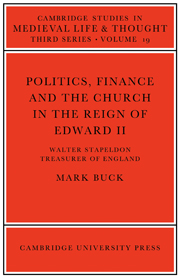Book contents
- Frontmatter
- Contents
- Dedication
- Acknowledgements
- Abbreviations
- 1 INTRODUCTION
- 2 FAMILY AND EARLY LIFE
- 3 THE BISHOPRIC OF EXETER
- 4 ROYAL FREE CHAPELS
- 5 THE FOUNDATION OF STAPELDON HALL
- 6 POLITICS AND DIPLOMACY 1309–13
- 7 THE CONSOLIDATION AND COLLAPSE OF ROYAL POWER 1320–1326
- 8 THE EXCHEQUER
- 9 THE CASE AGAINST STAPELDON
- 10 MURDER
- Appendix of documents
- Bibliography
- Index
- Frontmatter
- Contents
- Dedication
- Acknowledgements
- Abbreviations
- 1 INTRODUCTION
- 2 FAMILY AND EARLY LIFE
- 3 THE BISHOPRIC OF EXETER
- 4 ROYAL FREE CHAPELS
- 5 THE FOUNDATION OF STAPELDON HALL
- 6 POLITICS AND DIPLOMACY 1309–13
- 7 THE CONSOLIDATION AND COLLAPSE OF ROYAL POWER 1320–1326
- 8 THE EXCHEQUER
- 9 THE CASE AGAINST STAPELDON
- 10 MURDER
- Appendix of documents
- Bibliography
- Index
Summary
‘Homage and the oath of allegiance are more in respect of the Crown than in respect of the king's person and are more closely related to the Crown than to the king's person.’ This is the opening of a famous document proffered to Edward II, within a year of his accession, in April 1308. The purport of the document is unmistakably clear: the exile of the royal favourite, Piers Gaveston. Gaveston is not once mentioned in it by name but it was the demand for the favourite's exile which accompanied its presentation and which coloured its more specific proposals. Gaveston is the ‘person who is talked about’, who has withdrawn the king from the counsel of the realm, disinherited and impoverished the Crown, made himself the peer of the king, and so ensconced himself that ‘by his evil deeds it lies solely with him to determine whether the Crown should be destroyed and he himself made sovereign of the realm’.
Historians no longer write of the reign of Edward II as though there were being fought out during it a constitutional battle. It is no longer considered that opposing parties fought under ideological banners: the one, Lancastrian, with the Ordinances of 1311 as its manifesto, for limited monarchy, monarchy limited chiefly by parliament; the other royalist, with its private seals and household government, for unlimited autocracy; with a transient ‘middle party’ of politiques led by the earl of Pembroke exercising a precarious control during the middle years.
- Type
- Chapter
- Information
- Publisher: Cambridge University PressPrint publication year: 1983



